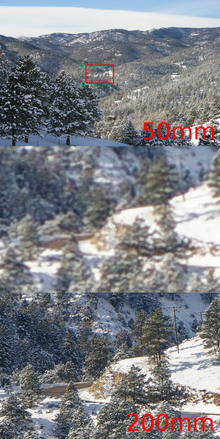This article needs additional citations for verification. (July 2020) |


Digital zoom is a method of decreasing the precise angle of view of a digital photograph or video image. It is accomplished by cropping an image down to an area with the same aspect ratio as the original, and scaling the image up to the dimensions of the original. The camera's optics are not adjusted. It is accomplished electronically, so no optical resolution is gained.[citation needed] Digital zooming may be enhanced by computationally expensive algorithms which sometimes involves artificial intelligence.[1]
In cameras that perform lossy compression, digital zoom is preferred to enlargement in post-processing, as the zooming may be applied before detail is lost to compression. In cameras that save in a lossless format, resizing in post-production yields results equal or superior to digital zoom.[citation needed]
Lower-end camera phones use only digital zoom and do not have optical zoom, while many higher-end phones have additional rear cameras, including fixed telephoto lenses that allow for the simulation of optical zoom. Full-sized cameras generally have an optical zoom lens, but some apply digital zoom automatically once the longest optical focal length possible has been reached. Professional cameras generally do not feature digital zoom.[citation needed]
- ^ "Image Zooming Using Corner Matching". Retrieved May 5, 2018.